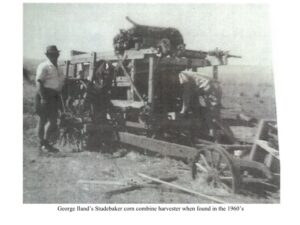|
A World First
Over a billion tons of corn is harvested annually worldwide with combine harvesters. While the first wheat combine harvester was patented in the US in 1835, it was another 80 years before the combine harvesting of corn was made possible. A Queensland inventor was the first to successfully build one.
From his teenage years, George Iland worked on his future father-in-laws Darling Downs property, maintaining and repairing his Massey Harris No. 2 wheat reaper-thresher. When it came to the corn (maize) crop, he felt there had to be a better way than hand picking corn and he set out to find one.
He is accredited as being the inventor of the corn combine harvester.
George used all the components of an accident damaged Studebaker he had purchased, to propel and drive the machinery of his corn combine harvester. The ‘Big 6’ motor was known to give good torque and power and George would have been seeking the most powerful motor he could find to adequately propel and power his large corn combine harvester. He used a pair of large portable steam engine wheels attached to a truck chassis, and a heavy timber frame for strength and to carry the weight. The Studebaker engine and radiator were mounted on top of the oak timber frame, driving down through the transaxle, connecting to the wheels and drive shafts (seen protruding in the right side of the photo) of his single row picker, elevator, and thresher. The cobs dropped into a bin and the cut up corn stalks were dropped to the ground, small enough to be ploughed under.
This machine is claimed to have been used for only one season in approximately 1920. The processing machinery parts were removed and probably used on a later harvester. Years later, George stated that he bought a Napier car for its motor, with the rest of the car going to the tip.That motor was fitted into another of his harvesters. The Studebaker was the only known self- propelled machine, others being horse drawn. In 1922, George had applied for a patent on his machine. After building seven of his horse drawn and powered machines and taking orders for 42 more, he approached the Eclipse Windmill Co Ltd of Toowoomba, who had been his foundry supplier, to partner and support his enterprise. However, the foundry directors told him that they were too busy on other foundry work! George and his friends were astounded at their short sightedness. No further machines were built. George’s health deteriorated as he had put everything into the venture. Years later he came back to harvesting as a contractor.
The Highfields Pioneering Village displays the only Eclipse machine existing today.

That Studebaker-powered machine sat on the farm for forty years, slowly sinking into the ground. During the 1960’s, all the Studebaker components, including the damaged front axle, radiator and chassis parts, were removed and saved. These parts went under water in the 1974 Brisbane floods.
In the 1990’s, these components formed the ‘faithful reconstruction’ of the Canada Cycle and Motor Agency Qld (CCMA) car as they had prepared it for its last major event, the Sydney to Brisbane record. Sadly, the Studebaker hit the fence, taking out six fence panels during a practice run for the 1919 Mt Coot-Tha hill climb, damaging the chassis and front axle.
Records show that at CCMA Brisbane, a new stock chassis, series 17, was fitted with an improved engine and radiator for race purposes. The radiator was a 1916 larger capacity honeycomb cored that was not supplied in Australian production cars that year. The motor carried no stamped number as it was not for production sales in 1916, but was Studebaker manufactured. The pointed tail body, used in the first land speed record, and removed for the Sydney to Brisbane record, was also made and fitted by CCMA in Brisbane.
Using original components and following the guidelines for a ‘faithful reconstruction’, rather than creating a replica, all parts in our car are original and when necessary, were repaired. None were re-cast or remade. All the 1916 series 17 casting numbers have been listed in a contents list of our vehicle. It is the only known 1916 6 cylinder Studebaker that survives in Australia. This is a similar project to the ‘faithful reconstruction’ of a Canadian police car 40 years ago.
With Australia being a member country of UNESCO and FIVA now representing Australian car enthusiasts, some may wish to read their latest handbook statement of guidelines to keep cars as original as possible. This handbook also includes comments on replicas, mentioning that there will be differing opinions.
Any further information would be appreciated. Gavin Mutton
|

